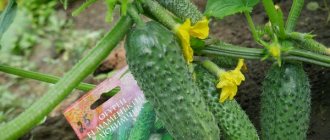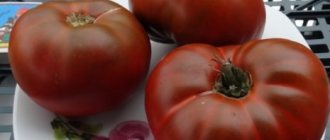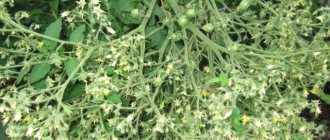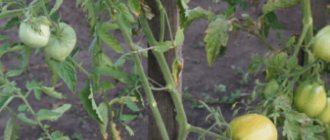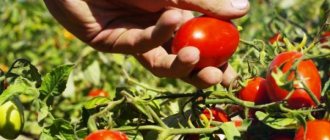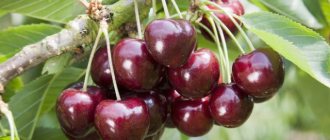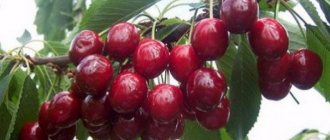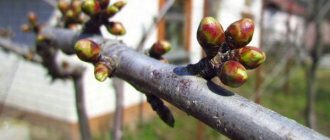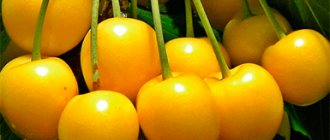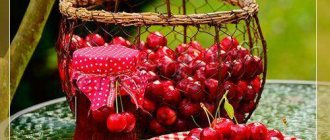Description of the variety
The plant is suitable for growing in the middle zone.
The tree is compact but grows quickly. In adulthood it grows to medium size. The crown has a round crown, is not very thick, spreading and at the same time very natural. The shoots are short and at the same time very strong; they have a brown tint. Vegetative buds have a cone shape, while fruit buds grow in the shape of an egg. Tyutchevka has fairly large oval-shaped leaves and at the same time they are pointed towards the end. The leaf is folded like a boat, its edges are jagged. The petioles are thick, the leaves are tightly attached to them. The leaf surface has a dark green tint with a shiny, smooth surface.
The berries of the tree are round, their weight can reach 7.4 g, they are located on short and very strong stalks. The height of the fruit reaches 2.2 cm, and the width is 2.3 cm. The skin of the berry is thin, but at the same time very dense, it has a red tint with specks. The pulp is dense and also red, very juicy. The stone has an oval shape and weighs 0.3 g; it is difficult to separate from the pulp.
The fruits have a sweet, excellent taste and a distinct cherry aroma. Tasters rated these berries quite highly, they received 4.9 points. When harvested, these fruits are easily separated from the stalks, do not become cracked, and do not dry out. These characteristics allow you to easily transport cherries over long distances.
Cherry Tyutchevka: planting varieties
Sweet cherry Tyutchevka: photo of the variety
The optimal time for planting the Tyutchevka cherry variety will be spring, so that the plant has time to take root well before the winter. When choosing a seedling for planting, you need to buy an annual or biennial plant, preferably from a trusted nursery. At the same time, it should already have leaves and twigs. It is necessary to carefully examine the entire seedling for various signs of disease: the roots must be strong, as well as the stems. In addition, there should be no scratches or damage to the bark and buds. If you bought a seedling with an open root system, then it must be placed in a clay mixture for several hours. It will be good to pre-soak the plant so that the root system can develop well.
If the Tyutchevka cherry seedling is in a container, then it can be planted in spring and summer in any month. It is not recommended to plant plants in autumn. When choosing a place for planting, you should know that the most delicious fruits will be formed on the tree that will grow in an open and protected from the sun place, protected from strong drafts by means of various buildings and structures or a fence. When planting a plant near a fence, you should retreat a distance of at least 2 meters.
The soil on the site should be loose, drained, neutrally acidic and rich in nutrients. It is not recommended to plant the crop next to nightshades, and the best neighbors for the plant will be other cherry or sweet cherry crops, which will increase the yield of the tree, and you can also plant cherries next to berry bushes. The distance between plantings should be at least 4 meters.
First you need to prepare a planting hole, which will measure 60 by 80 cm. A fairly thick layer of drainage is laid out in it, and the ground is also dug up. A support is immediately placed in the center of the hole, to which the young tree will be tied. Then the seedling is placed on a mound, carefully straightening the entire root system. Next, you need to cover the planting with fertile soil. When planting, you should ensure that the root collar is at least 5 cm above ground level. In addition, it is necessary to compact the soil and also form a circle around the trunk so that moisture does not spread during watering.
After the tree is planted, it is necessary to water the seedling with a bucket of water and lay out a thick layer of mulch. Formative pruning can begin immediately.
When buying a seedling of the Tyutchevka cherry variety, you should not confuse sweet cherries with cherries. They differ precisely in the shade of the bark: cherry has a gray-brown tint, while sweet cherries have a red tint to the bark.
Diseases and pests
Tyutchevka gets sick very rarely, and with the right agricultural technology it doesn’t come down to serious medications. The usual preventative measures are enough: rake and burn the leaves after leaf fall, clear the loose bark and dig up the area. Many gardeners do not neglect preventative spraying of trees with copper-containing preparations in early spring. Most often they use 1% Bordeaux mixture.
Among the cherry diseases that you should pay attention to, in the case of Tyutchevka, only coccomycosis and klyasterosporiosis are named. Coccomycosis is a dangerous fungal disease. At the end of spring, brownish spots up to 2 mm in size form on the leaves of the infected tree, and after a month without treatment they merge into solid large spots. Dirty pads—fungal colonies—appear on the underside of the leaf. Leaves fall prematurely.
Coccomycosis should not be underestimated: spots on the leaves eventually destroy them and greatly weaken the tree
The disease often spreads to other parts of the plant, as a result of which the tree becomes very weak and may die. Coccomycosis is treated first (in the spring) with the same Bordeaux mixture, but 3%, and if it does not help, then special drugs are subsequently used: Horus, Skor, etc. throughout the season.
Clusterosporiasis (hole spotting) is also fungal in nature and begins similarly to coccomycosis, but subsequently holes form in place of the spots. Prevention and treatment measures are the same as for coccomycosis.
With klyasterosporiosis, the leaves become as if shot through, and everything ends very badly
The Tyutchevka cherry has almost no pests, except for the ubiquitous cherry fly. “Wormy” fruits are the result of its activity, and “worms” are fly larvae. Conventional agrotechnical measures significantly reduce the risk of its occurrence. And they try to fight the fly without chemicals, catching it with bait: kvass or compote in hanging jars. If the fly has multiplied greatly, it is necessary to use insecticides: for late varieties of cherries, which include Tyutchevka, spraying is possible even immediately after flowering.
The fly is quite beautiful, but traces of its activity are completely unpleasant for the gardener
The list of active drugs is wide, but gardeners try to use the most modern ones, and many of them are dangerous for humans. Therefore, strict adherence to the instructions when working, for example, with Actellik or Confidor is mandatory.
The cherry aphid may also visit Tyutchevka. A variety of aphids are well known to gardeners. This one is black in color, up to 3 mm in size, sucks juices from young shoots and leaves. It is especially dangerous in the first half of summer. As with other aphids, they try to fight it using folk methods (infusions of elderberry, wormwood, garlic, etc.), but in case of a massive invasion they use the same insecticides as against the cherry fly.
Like any aphid, the cherry aphid lives in entire colonies
Fruit
The Tyutchevka cherry tree is famous for its fruits. They are beautiful, smooth, bright red in color. The minimum weight of one berry is 5 grams, the maximum is 7.3. The shape of the cherry is wide-round, there is a medium-sized funnel.
We suggest you read: What is the best time to eat walnuts?
The skin is thin, but it is enough to protect the juicy pulp from damage. Of course, if the summer is too rainy, then due to high humidity it can crack, and the wounds heal quickly, resulting in brownish scratches. The juice of the pulp is red, like the berries. Inside there is a rounded stone, which is not very well separated even from the most mature pulp.
Plant characteristics
This variety can be called almost self-sterile. If there is no pollinator, the harvest will be too poor. Any cherry trees that bloom along with Tyutchevka can act as pollinators. It is worth giving a list of the best trees that are suitable for pollinating Tyutchevka:
- Ovstuzhenka;
- Raditsa;
- And the way;
- Bryansk pink.
If cultivation is carried out on an industrial scale, the yield will be 100 centners per 1 hectare. In garden plots, the yield is 2 buckets per tree, and the maximum yield was 40 kg per tree. Gardeners say that a tree should produce a good harvest for at least 20 years. This variety easily tolerates frosts down to -25 degrees. At a temperature of -35 degrees, about 20% of the buds will freeze. If frosts return again down to -5 degrees, they will kill up to 70% of the buds on the tree.
More detailed characteristics of the plant in the video:
Cherry “Iput” is one of the most popular varieties
Summer has many associations. This is the smell of meadow grass, and the chirping of swallows, and the taste of juicy and aromatic cherries. If you have your own plot of land, then by all means try to grow it.
There are about 4,000 varieties of this plant in the world. They are all divided into guini and bigarro. The first include mainly early varieties with sweet, juicy and tender berry pulp. Their juice is almost colorless. Such cherries are not easily transportable and are not subject to long-term storage; they are intended for table use.
Bigarro refers to cherries with elastic, dense and crispy flesh. Its juice may be slightly colored or colorless. These varieties are good both fresh and processed. And mostly they are late or mid-ripening.
Just half a century ago, a crop such as cherries was considered only a southern plant. But thanks to the work of breeders and climate warming, it began to grow in the northern regions. Now it is often found in areas of the middle zone. Even the suburbs of St. Petersburg can boast of it.
“Iput” cherries (the photo shows how beautiful these berries are) must be planted correctly. It should definitely be taken into account that cherries in most cases are cross-pollinated trees. Therefore, high yields will only occur if there is a pollinating variety on the site, for example, “Iput” cherry. The tree is characterized by intensive growth of shoots, so they are pruned annually. This is done only in the spring, before the buds have yet swelled. Annual shoots are shortened by 1/5.
Russian varieties that are ideal for the middle zone
The “Iput” cherry variety is an early ripening dessert cherry. It is resistant to diseases and pests. A tree with a raised, wide-pyramidal crown. It will bear fruit in the 4th year after planting. The fruits of this variety are dark red, large and one-dimensional. They are heart-shaped and sweet in taste. It is used both fresh and for compotes, jams, juices, preserves and fruit wine. “Ostuzhenka”, “Tyutchevka” and “Bryansk pink” are suitable as pollinators.
"Crimean" refers to a winter-hardy variety. Tree with a spherical crown. The fruits are small, ripen early, and their juicy pulp resembles the taste of bird cherry. It makes excellent compotes and jam.
"Bryansk pink" is a winter-hardy, self-sterile variety,
“Cheremashnaya” is a tall tree with an elongated, spherical, raised crown. Refers to medium-winter-hardy varieties. It has very tasty, large, sweet and sour yellow fruits. Pollinating varieties include “Iput”, “Fatezh” and “Crimean” cherries.
"Tyutchevka" with a high yield, the cherry is early-fruiting and winter-hardy. The medium-sized tree has sweet, large, spherical fruits of a dark red color. Pollinating varieties include “Iput”, “Revna” and “Bryansk pink” cherries. “Tyutchevka” is good both fresh and processed.
fb.ru
Reviews from gardeners
Many gardeners and summer residents in the middle zone speak positively about this variety. They note that if the planting conditions are met, it is not difficult to care for the tree in the future: it is enough to water it during drought, treat it against pests and feed it, observing the deadlines. Everyone likes the fruiting and taste of Tyutchevka. The compact size of cherries allows them to be planted even in small areas.
Most gardeners note good transportability of fruits, resistance to diseases, high yields, and the ability to maintain the ability to bear fruit even after severe frosts.
This variety of cherries does not have any significant disadvantages. Gardeners note one significant disadvantage - cracking of fruits in conditions of high humidity. Special attention is not paid to it, since this circumstance does not greatly affect the harvest.
Early ripening varieties of cherries
And the way
Thanks to the combination of winter hardiness and taste, the Iput cherry variety has become one of the most famous varieties in Russia and abroad.
The fruits of the variety are quite large, weighing 5-9 grams. Their pulp is tender and sweet, and the berries sometimes crack towards the end of ripening.
Iput begins to bear fruit a little later than the previous variety - at 4-5 years. But the latter has higher winter hardiness and resistance to fungal diseases. It can be pollinated by Tyutchevka, Radnitsa, Bryansk rosea, Ovstuzhenka, and Revna.
Chermashnaya
Chermashnaya takes not in size, but in quantity. With an average berry size of up to 5 grams, trees of this variety provide high productivity and, with proper care, leave their peers behind.
It tastes good too: Chermashnaya berries are sweet, with a slight sourness.
This variety's resistance to cold and disease is average. The first parameter is enough for growing in the conditions of the Moscow region, the second - to protect yourself from major fungal diseases.
Ovstuzhenka, Fatezh, as well as Iput and Raditsa can pollinate Chermashnaya.
Advantages and disadvantages of the variety
All the advantages and disadvantages of the plant can be presented in the form of a table.
| Advantages | Flaws |
| Increased resistance to severe frosts. Without shelter, the tree feels normal at a temperature of -25 degrees. In frosts down to -35 degrees, the branches may be slightly damaged, but in the spring the plant will easily recover. | The plant is afraid of high humidity. With frequent rains, the berries will crack. |
| Excellent taste of juicy berries, which received 4.9 points from tasters. | Poor self-pollination. |
| The shelf life of the berries is quite long, they can be easily transported. Despite the thin skin, it is quite strong and protects the integrity of the berry well. |
Taste qualities
The berries are endowed with incredible taste. Tasters rated this quality 4.9 points out of a possible five. The pulp is dense, very juicy. The taste is sweet and very pleasant, there is not a hint of sourness or cherry tartness. Taste qualities may vary depending on weather conditions. If the summer is hot and sunny, then the fruits accumulate a lot of sugar. If the season has a lot of rain and few sunny, fine days, then the taste will not be so bright. It will not become sour, like a rainy morning, but you will also feel less sweet. The pulp will become more watery and the taste will be the same.
Tyutchevka cherries are endowed with high transportable qualities. Reviews from gardeners confirm the description of the variety. They write that the berries do not cake, do not wrinkle, do not lose their shape and, accordingly, their presentation.
Planting cherries on the site
Many factors influence the development and productivity of Tyutchevka. But the most important of them is the correct and timely planting of seedlings.
Recommended timing
Planting seedlings depends on the climatic conditions of the region of residence. In the southern regions the tree is planted in the fall. Before the onset of frost, the plant has time to take root and can easily withstand the winter cold. In areas with early frosts, trees are planted in open ground in the spring. This procedure is done immediately after the snow melts, before the first buds on the trees swell.
Selecting a site and preparing a planting hole
Cherry does not like the close proximity of other fruit crops. Therefore, a plot of garden or vegetable garden is allocated for seedlings at a distance of at least 5 meters from other plants. Trees will grow and develop better on a small hill or plain on the southern side of the site, well illuminated by sunlight.
An important point when planting seedlings is the condition of the soil. Trees love fertile, loose soil.
Planting seedlings begins with digging a hole:
- Depth – 50-70 cm.
- Diameter – 60-90 cm.
The dug hole is filled with earth mixed with humus and fertilizers. The pit should remain in this form for 1-1.5 months and only then trees should be planted in it.
Important! The place for planting seedlings is prepared and fertilized in advance. Soil containing high acidity is neutralized with lime.
How to choose a healthy and strong seedling
You need to select and buy seedlings of a hybrid fruit plant in special nurseries or garden centers. First of all, examine the appearance of the seedling. It should be without obvious damage, free from broken branches, mold deposits, traces of pests and rotting. The age of a plant ready for independent growth in open ground is 1-3 years.
When examining a seedling, special attention should be paid to the root system. The roots should not have obvious damage and should be carefully cut, but not too short. The main determining factor in choosing the right variety is the leaves of the Tyutchevka cherry. They have an oval shape with a pointed top, the stalk is short, almost invisible.
Technological process of disembarkation
Purchased seedlings are planted in pre-prepared holes. The root system of the plant is carefully distributed in the hole and sprinkled with earth. There should be no voids without soil between the roots. The soil around the plant is carefully compacted. After successful planting, the tree is watered abundantly.
Landing Features
Since Revna is intended for cultivation in areas with a temperate climate, the only possible time for planting a seedling in the ground is early spring, as soon as the soil has thawed sufficiently. You need to catch it before the tree’s leaves bloom, otherwise it most likely will not take root in the new place.
But no one forbids growing Revna in warm southern regions. In this case, the planting date can be moved to the beginning of September.
Choosing a location and seedling
The choice of location is extremely important. Any cherry is a heat- and light-loving crop that absolutely does not tolerate cold and sharp drafts. The best place for Revna is the southern or southwestern slope of a gentle hill. Lowlands where moist cold air often stagnates and melt water accumulates in the spring, areas where buildings and structures cast shadows, and places where groundwater comes closer to the surface than 1.5–2 m are not suitable.
The soil is preferably nutritious, but light and breathable. The ideal option is fertile loam, forest gray soil, sandy loam soil. Cherries will not grow in heavy silt, clay, or peat substrates. The situation can be partially corrected by building a hill and adding coarse river sand to the planting hole. If you have the opposite problem (sandy, gravelly soil), add clay to the soil when planting and provide the plant with regular watering.
Experienced gardeners note that there is no significant difference between one-year and two-year-old seedlings
When choosing, be sure to pay attention to the roots and the presence of a characteristic tubercle - the grafting site. If the trunk is completely smooth, the seedling is grown from a seed
Perhaps this is Revna, but in the vast majority of cases such trees do not retain varietal characteristics.
Preparation for planting and planting in the ground
Planting Revna cherries is a procedure that even a novice gardener can handle
The planting hole is prepared in the fall; it is approximately 60 cm deep and 65–70 cm wide. Ideally, the selected area should be plowed, because Revna’s roots go 1.8–2 m deep.
A support at least 20 cm higher than the seedling is strengthened at the bottom. The top 20 cm of fertile turf soil is mixed with 50–60 liters of rotted manure or humus and poured back, forming a small mound.
If you are not satisfied with the soil fertility, add 120–150 g of simple superphosphate and 50–70 g of potassium sulfate. Urea should not be added; it can greatly harm young cherries, especially if overdosed. The time for nitrogen-containing chemical fertilizers will come only in the second year after planting.
Dolomite flour or wood ash (500–600 g or a liter jar), which reduces soil acidity, is also useful. Like all stone fruits, cherries prefer slightly alkaline soil.
The procedure itself looks like this:
The seedling is placed on top of an earthen mound that has been watered 15–20 minutes before and the roots are carefully straightened, making sure that they do not bend upward
Fill the hole with small portions of earth, periodically carefully compacting the soil with your hands so that there are no air-filled voids left in it. Constantly monitor the position of the tree
When you reach the top edge of the hole, the root collar should be 6–8 cm above it. Compact the soil again, but do not trample on it. Tie the seedling to a support. Form a low earthen mound. Water the tree. 4–5 liters of heated water is enough. Wait until the moisture is completely absorbed into the soil. Mulch the tree trunk circle. This will significantly reduce the time spent on watering and weed control. Freshly cut grass, sawdust, dry peat, and fallen leaves are suitable.
Cherry care
This fruit tree is grown without any difficulties. The tree trunk needs to be cleared of weeds and the soil loosened, but only after watering, if there is not enough rainfall during the season.
It is especially important to moisturize during the period when the plant is in the bud or ovary phase, as well as in the autumn, when preparations are being made for the winter season. If there is a lot of rainfall during the berry ripening season, it is better to cover the soil under the tree with film, otherwise the cherries will begin to crack.
You can feed Tyutchevka with organic substances and complex fertilizers. Damaged branches must be removed from the plant in autumn or early spring. Young trees should be protected from rodents; for this, agrotextiles, thick paper or mesh are used.
Features of care
Timely watering, fertilizing and pruning of the fruit tree is the key to obtaining a high-quality and large harvest of berries.
Watering mode
In regions with a temperate climate, trees are watered no more than 3-4 times throughout the entire season. During prolonged and heavy rainfall, the tree trunk circle is covered with a film, protecting the soil under the tree from severe waterlogging.
In southern, arid regions, watering is done as needed, as soon as the top layer of soil dries out.
Important! During the period of flowering and berry formation, the amount of watering is increased.
Feeding and fertilizer
For better growth, development and fruiting, cherries require additional feeding and fertilizer. Provided the soil is fertile, fertilizing is applied for the 2-3rd year of tree growth.
Spring
In early spring, cow manure diluted with water and mineral fertilizers are added to the soil.
Summer
During the period of flowering and ripening of berries, trees need potassium and phosphorus, so a mineral complex is used for fertilizer.
Autumn
In the fall, after the final harvest, cherries are fed with minerals and organic compounds.
Crown formation
Correct formation of the crown will allow you to get a large harvest of cherries. Pruning begins in the first year after planting the tree in open ground.
First year
As soon as the planting work is completed, the seedling is pruned to 6-7 buds, from which the first skeletal branches will subsequently grow.
Second
In the second year of growth, 4 of the strongest shoots are selected from the tree to form the lower tier, the rest are removed.
Third
In the third year of growth, the formation of the lower tiers of the tree continues and the skeletal branches of the second level are laid.
Fourth
When pruning cherries in the fourth year of growth, the formation of skeletal branches of the second level continues and the next level of branches is laid.
Further, the fruit tree only requires crown thinning and sanitary treatment.
Preparing for winter
Before wintering, the trees are moistened abundantly, the trunk circle is mulched with a thick layer of humus and spruce branches.
The lower part of the trunk is treated with lime and covered with burlap or special material. Also, to avoid damage to the tree by small rodents, the trunk is wrapped in mesh.
As soon as the first snow falls, a large snowdrift is raked under the tree.
Weeding and loosening
Weeds are carriers of fungal and viral diseases, as well as pests. Therefore, several times during the season the tree trunk circle is weeded, loosened and mulched.
Spring treatment
In the spring, sanitary pruning of trees is carried out, removing frozen, dry and damaged branches and shoots. After pruning, the cut areas are treated with garden varnish.
Crown thinning for an adult tree
Over the years, many old branches appear on the tree and stop bearing fruit. In late autumn, after harvesting, old and improperly growing branches are removed, which stimulates the growth and development of fresh tree shoots.
Diseases and pests
Cherry variety Tyutchevka is resistant to some fungal infections and pests. But if not properly cared for, the tree becomes sick and is attacked by insects.
Clusterosporiasis
The fungal disease affects not only the leaf cover of the plant, but also flowers, branches and buds.
The disease manifests itself as brown spots, which enlarge and darken over time, subsequently holes form at the site of the damage.
For treatment and prevention, preparations based on fungicides containing copper are used.
Moniliosis
Moniliosis manifests itself as a gray coating on the fruits, under which the berries rot. The affected shoots are removed and burned, the trees are treated with copper sulfate or special means.
Scab
Affected leaves become covered with brown spots, curl and dry out. For treatment and prevention, trees are treated with special preparations containing fungicides and copper.
Cherry aphid
The pest feeds on the sap of cherry leaves and fruits, which leads to the tree drying out and stopping fruiting.
As a preventive treatment and treatment, the plant is treated with insecticide-based preparations.
Hawthorn
The butterfly looks like a cabbage butterfly. The pest poses a particular danger in its caterpillar stage, which quickly destroys not only the green mass of the tree, but also the crop. Insecticides are used for control and prevention.
Sapwood
A small beetle that appears in the bark of an infected tree in late spring. With inactivity, the yield of a fruit crop falls and immunity to disease is significantly reduced.
To combat the pest, only professional products help.
History of origin and region of growth
Tyutchevka appeared in the State Register in the early 2000s. The basis of the new plant variety was the “3-36” cherry, crossed with the “Red Dense” variety. Work to create the species was carried out at the Bryansk Research Institute.
The result is fruit crops that are resistant to harsh winter climates. Now the tasty berry variety Tyutchevka is grown both in the southern regions of the country and in the Urals. But the new cherry variety got its name because of the chief breeder’s love for the poetry of the great poet Tyutchev.
Characteristics of the variety
The Tyutchevka cherry variety was bred specifically for regions with temperate and harsh climates, but in the southern parts of the country, this plant also feels good.
Frost resistance and drought resistance
Sweet cherries easily tolerate harsh winters and even during the flowering process, slight frosts are not a hindrance for them. After hibernation, the variety quickly enters its life cycle and gains strength. Tyutchevka cherry is resistant to arid climates, but during severe and prolonged drought it requires additional moisture.
Reviews
Anastasia, Moscow:
An incredibly durable cherry variety for our winters. I have been satisfied with my harvest for many years. Caring for the tree is the simplest, and it has its own high resistance to diseases and insects; no special treatment is necessary. Well, what can we say about the taste of the berries, they are simply magnificent.
Valentina, Ryazan:
Several years ago I planted Tyutchevka at my dacha. The tree has already grown noticeably. During all this time I did not have to fight pests or treat diseases. The tree is beautiful and grows independently. All I can do is periodically adjust the crown and wait for my first harvest, especially since these berries have simply excellent taste.
Mikhail, Rostov-on-Don:
The incredible Tyutchevka cherry tree became our celebrity on the site. We have not tried such berries yet. The incredible taste and aroma makes you pick cherries ahead of time. Our whole family grew this seedling and now we are all enjoying the fruits of our efforts.
Cherry Tyutchevka: features of the variety
Sweet cherry Tyutchevka: photo of the variety
The Tyutchevka cherry begins to bear fruit 4 years after planting. At the same time, the maximum amount of harvest can be harvested within 10 years after planting. One tree can bear 16 kg of fruit. With numerous plantings, almost 100 centners of berries can be harvested from one hectare of cherries.
However, if the tree grows in suitable conditions and the necessary care is taken, then one crop can produce 40 kg of berries. The lifespan and fruiting life of the tree is 20 years.
Tyutchevka cherries have a universal purpose: they are consumed fresh, used for preparing preparations in the form of jam, confiture and compotes. To preserve the maximum amount of vitamins, the berries can be frozen.
When developing the Tyutchevka cherry variety, emphasis was placed on high immunity to various diseases common to cherries. Therefore, this plant is rarely affected by moniliosis, as well as diseases such as clusterosporiosis and coccomycosis. In order for these properties to take place, it is necessary to follow the rules of caring for wood.
Agricultural technology
Daibera cherry
Novice gardeners often confuse cherries and sweet cherries. Trees are identified by their bark. In the first species it is colored in gray-brown tones, and in the second it is completely brown, with reddish tints. The branches of the cherries are straight, and the seedlings themselves are tall.
To plant and grow a hybrid, you need to correctly select a viable specimen based on the following characteristics:
- its age should be at least 2-3 years, it is better to take three-year-old hybrids;
- the cutting should be 0.8-1 m in length and have up to four healthy shoots;
- purchase a specimen with a trace of grafting on the smooth bark, as this is a guarantee that it was grown in a nursery;
- the roots of the seedling must have at least 3 shoots 20-40 cm long, in this case the seedlings will take root well on the site;
- the tree should not show signs of rot or brittle branches.
If the root system is dried out and its cut is colored brown, to save the sample you need to put it in a bucket of water for 24 hours. If these measures do not help, you will need to purchase another seedling.
Cherry seedlings
An adult hybrid does not like windy or sunlit places. Therefore, for Tyutchev’s cherries, choose areas on the south or south-west side, preferably behind the wall of a building - it will protect the trees from the wind.
Note: the tree dies from excessive moisture, so it needs to be planted in places where groundwater is not suitable, for example, on a hillside.
For the seedling, loamy soil with neutral acidity is selected. It is prohibited to plant Tyutchev's cherries on clay, peat or sandy soils. This will lead to the death of the plants.
If the soil in the garden has high acidity, to neutralize it, sprinkle the soil with lime (0.5 kg per 1 sq. m). Chalk is also used for these purposes. After filling the substance, the soil is dug up. If the farmer lives in the southern part of the country, it is better to plant Tyutchev cherries in September or early October (but no later than the 15th of this month). In the middle zone, the gardener will have to carry out this work in the spring. The best time is April, before the buds swell.
The procedure is carried out as follows:
- The hole box is dug no later than a week before planting. Its depth should be 0.5-0.7 m, and its width should be up to 100 cm. The distance between adjacent holes should be at least 3-3.5 m, otherwise the trees will touch their crowns and shade each other. You need to drive a peg next to the plant. The seedling will rest on it as it grows.
- Fertilizers are added to the pit. For 1 Tyutchev cherry seedling you will need 2 tbsp. l. phosphate, 1 bucket of humus, 1 tbsp. l. potassium sulfur. To prevent the roots of the trees from getting burned, all substances are covered with a layer of earth.
- After planting, the soil around the seedlings is well compacted, watered with plenty of water, and then mulched with dry grass.
To protect the root system of Tyutchev's cherry from burns, it is straightened and then dipped in a clay mash.
Watering seedlings should be regular
Watering the seedlings should be regular, but during rains it is better to protect the plants with film.
There is no need to feed Tyutchev's cherries for the first 3 years. When the tree is 4 years old, chicken droppings or rotted manure diluted with water (1:10) are added to the soil. For 1 sq. m of crown shadow on the ground, goes up to the bucket of fertilizer. This fertilizer should be used no more than once every 3 years. For Tyutchev's cherries, urea is suitable, which is added in the amount of 30 g per 1 square meter. m shade of the tree crown. This procedure is carried out in the spring, when the weather is warm and it rains.
Note! This hybrid does not need pruning to form a crown, but sanitary maintenance is carried out regularly. To do this, remove broken and diseased branches, and cover the cuts with garden varnish.
Hybrids are protected from various diseases with special preparations that destroy fungi and microorganisms. For prevention, it is enough to carry out such work 2 times a year. To protect against pests, Tyutchev's cherries are sprayed with a solution of wood ash and soap shavings in water. If dangerous insects still appear, they are destroyed using special preparations.
For normal fertilization, pollinators are planted next to the seedlings. Suitable hybrids are Ovstuzhenka, Raditsa, Bryansk pink, Revna, Lena. If these varieties are planted on a neighboring plot, the farmer does not have to worry about pollination - it will happen automatically.
With proper care, cherries will give a good harvest
Planting and care
Tyutchevka is an unpretentious variety, but to obtain a rich harvest, you must carefully follow the rules of planting and care.
Selection of seedlings
For planting, you must select a strong, viable young tree.
When choosing planting material, you should pay attention to the following points:
- A seedling that is 2–3 years old is better suited;
- the cuttings must be strong, at least 80 cm long, with 3-4 healthy shoots;
- the mark of the graft on the bark will convince you that this is a varietal seedling and not a wild one;
- the bark of a good seedling should be absolutely smooth;
- the root system must have at least three branches, the length of each should not exceed 20 cm;
- the seedling should not be completely dry or show signs of rot. If the roots are dry and brown when cut, you need to keep the tree in water for a day before planting, and it will be saved.
Video: choosing the right seedling
Choosing a landing site
Cherry loves the sun and does not like wind, so it is better to choose a secluded place for it on the south or south-west side, thinking in advance so that the seedling is protected from the wind, for example, by the wall of a house
It is important to remember that the cherry root system does not tolerate even the slightest stagnation of water. It is better to plant a tree on a slight slope
Soil preparation and planting
Choosing a good location is half the battle; now you need to properly prepare the soil. Loamy soil with neutral acidity is ideal for Tyutchevka. Peat, clay and sandy soils are not suitable for the tree.
In the southern regions, seedlings can be planted in the fall, until mid-October, but in the middle zone it is better to wait until spring. The tree will take root if it is planted in April before the buds swell. The landing algorithm looks like this:
- We dig a hole no later than a week before planting. The depth should be at least 50 cm, the width - about a meter, the distance between the holes - at least 3 m.
- We place fertilizers at the bottom of the hole: a bucket of humus, 2 tbsp. l. superphosphate and 1 tbsp. l. potassium sulfur. Fertilizers should be sprinkled with a little soil so that the roots do not get burned. To protect the delicate root system from burns, dip the straightened roots into earthen or clay mash.
- After planting the seedling, the soil is compacted well, watered abundantly and mulched with dried grass.
After planting, cherries require abundant watering and mulching.
Features of care
The Tyutchevka cherry is unpretentious and does not need special care, but there are still some nuances.
Watering
Organize regular watering, focusing on the weather conditions of your region. Also prevent possible waterlogging: if the summer is very rainy, cover the ground under the tree with film during the rainy season.
Top dressing
For the first 3 years, you do not need to apply any fertilizers - the tree will only need what you added to the soil when planting. Starting from the fourth year after planting, use chicken droppings (diluted with water in a ratio of 1:10) or manure (preferably rotted) as top dressing. For each square meter of tree crown projection, use a bucket of organic fertilizer
It is important to remember that manure and droppings should be used no more often than once every 2-3 years, because excess fertilizer can also harm the tree
Nitrogen fertilizers, such as urea, are also useful for cherries. It must be applied in the spring, preferably in rainy and warm weather. The rate of application of urea is 30 g per 1 m2 of crown projection.
Prevention of diseases and pests
“Dusting” with ash is suitable for this purpose. You can lightly spray the trunk and branches with it (to do this, add a little water and soap shavings), and also sprinkle the ground under the tree.
Trimming
Cherry trees do not need formative pruning, but in the fall you need to carry out sanitary pruning - remove all diseased and damaged branches, and cover the cuts with garden varnish.
Cherries do not require mandatory pruning
Pollination
It is important to remember that Tyutchevka has a weak ability to self-pollinate (only up to 6% of ovaries). Therefore, the tree needs the “right” neighbor with a suitable flowering period: this guarantees pollination for the tree and a high harvest for you. The best neighbors for Tyutchevka are cherries of the varieties Revna, Ovstuzhenka, Iput, Bryanskaya pink, Bryanochka, Lena, Raditsa
The best neighbors for Tyutchevka are cherries of the Revna, Ovstuzhenka, Iput, Bryanskaya rozovaya, Bryanochka, Lena, Raditsa varieties.
By the way, a tree in a neighboring area would also be suitable. Insects will definitely look from it to you. But if you decide not to rely on your neighbors, plant several trees on your site at once.
Cultivation care
The Tyutchevka cherry variety is considered unpretentious. However, in order to get a large harvest of tasty and healthy fruits, you still have to make an effort.
Irrigation and fertilization of trees
Cherry does not tolerate heavy soil moisture. Watering is necessary for the plant based on the weather conditions of the region. In the middle zone of the country, it is enough to irrigate the tree abundantly only 3 times a season. In hotter areas, the watering schedule should be more frequent. During prolonged rains, the area of ground under the tree is covered with film or other waterproof materials.
If the seedlings were planted according to all the rules, then the tree will not need additional feeding for 2-3 years. Next, the cherries are fed in the spring, once every 2-3 years, with natural and nitrogen fertilizers.
Rejuvenating and shaping pruning
Young trees undergo formative pruning annually. This procedure allows you to extend the life of the plant and get a high yield.
To do this, several strong shoots are selected, which will serve as the base of the crown, and the remaining branches are cut off. Every year the tree increases by 1 tier. Pruning is done in the spring, while the cherry tree is dormant. In mature trees, root shoots and weak or dry branches are pruned.
Tree trunk care
Loosening, hilling and mulching of the tree trunk circle is especially necessary in arid regions. The procedure is also carried out before the winter months. Throughout the season, weeds and young growth that interfere with development and growth are removed around the trunk.
Preventative treatments
Every year, preventive spraying is carried out in spring and autumn. It is best to carry out such procedures with natural preparations that you can prepare yourself. But if this is not possible, then special products can be purchased in stores.
Important! Chemicals are used with caution during fruit ripening .
Shelter for the winter
Preparatory work for wintering cherries includes the following steps:
- Abundant watering of trees. Moist soil protects the root system from frost because it freezes much more slowly than dry soil.
- Plants are insulated with burlap or special fiber.
- During snowy winters, snowdrifts are raked around the trees.
- The bark is coated with manure or lime, covered with mesh or roofing felt, otherwise forest animals will damage the plants.
By following all the rules for growing and caring for Tyutchevka cherries, you will get a large and tasty harvest.
Sources used:
- https://sornyakov.net/trees/chereshnya-tyutchevka.html
- https://diz-cafe.com/sad-ogorod/chereshnya-tyutchevka-opisanie-sorta.html
- https://rassada.info/chereshnya/tyutchevka.html
- https://dachamechty.ru/chereshnya/tyutchevka.html
- https://7ogorod.ru/plodovye-derevya/ceresna-tutcevka.html
Diseases and pests
It was noted that the Tyutchevka cherry variety has high immunity to common fungal diseases. However, it is necessary to remove all fallen leaves and fruits in the fall and be sure to dig up the area before the winter period. When spring has just begun, it is necessary to carry out fungicide treatment for preventive purposes.
In addition, you should take care of the tree and periodically use hunting belts and other traps when attacked by insects, and if there are too many pest insects, then insecticides will be needed.

